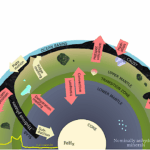Now Reading: Enigmas of Time: Unsolved Mysteries of Humanity’s Past
-
01
Enigmas of Time: Unsolved Mysteries of Humanity’s Past
Enigmas of Time: Unsolved Mysteries of Humanity’s Past


60 Archaeological Mysteries Science Still Can’t Explain
Across the globe, mysterious artifacts and structures emerge, challenging our understanding of human history and ancient civilizations. These enigmas often defy explanation, haunting scientists and historians alike. Each discovery has the potential to unravel the fabric of historical narratives we have woven over centuries, yet just as many leave us with more questions than answers. Here are some of the most intriguing archaeological mysteries that continue to baffle researchers.
The Great Pyramid of Giza: One of humanity’s most iconic structures, the Great Pyramid remains shrouded in questions regarding its construction. Built over 4,500 years ago, it represents an unparalleled feat of engineering given the resources available to the ancient Egyptians. Despite extensive research, the precise methods used to transport and position the 80-ton limestone blocks remain elusive. Theories about how the Egyptians achieved such remarkable accuracy in alignment and dimension, including their celestial observations and sophisticated surveying techniques, continue to inspire debate among Egyptologists.
The Nazca Lines: These colossal geoglyphs etched into Peru’s arid landscape have perplexed researchers for decades. Stretching over 1,000 kilometers, the lines depict animals, plants, and geometric patterns, with various theories suggesting they served ritualistic, astronomical, or practical purposes. Their sheer scale can only be fully appreciated from the sky, prompting questions about the means by which the ancient Nazca culture created such incredible designs. Were they messages to the gods, or perhaps markers for ceremonies related to agriculture and water?
Pumapunku: Situated in Bolivia, this ancient site is part of the Tiwanaku complex, which is known for its massive stone blocks, some weighing over 100 tons. The construction techniques employed here remain a source of speculation, with some suggesting advanced knowledge of stonework that has been lost to time. The precision with which these blocks fit together is astounding, prompting theories of lost technologies or supernatural assistance. How did ancient builders transport these enormous blocks over mountainous terrain, and what methods did they use to achieve such precision?
Gobekli Tepe: Often regarded as the world’s oldest known temple, this site in Turkey dates back to approximately 10,000 BCE, predating even the advent of agriculture. The massive T-shaped pillars, intricately carved with reliefs of animals and abstract symbols, challenge previous notions about the timeline of human civilization. The presence of organized religion and monumental architecture at such an early stage in human history raises profound questions about the social structures and beliefs of hunter-gatherers.
The Colossal Stone Heads of the Olmecs: These iconic sculptures, some weighing up to 40 tons, were crafted from basalt boulders. Which methods were employed to transport and carve these massive heads is still largely speculative, leading some to think the potential for lost technologies or even extraterrestrial help. This advanced artistry speaks to the capabilities of the Olmec people, yet remains an enigma, especially given the geographical constraints of their time.
Easter Island’s Moai Statues: The Moai statues, serving as silent sentinels of a vanished civilization, were created by the Rapanui people, embodying their rich spiritual heritage. Standing as tall as 30 feet and weighing as much as 86 tons, questions abound regarding how these colossal figures were transported and erected. Current theories suggest that the Rapanui used a combination of logs and ropes, yet the sheer scale raises further curiosities regarding their social structure and the resource management that allowed for such labor-intensive projects.
Derinkuyu Underground City: In Turkey, this subterranean marvel could accommodate up to 20,000 people. Carvings show complex ventilation systems, living quarters, storage rooms, and even churches. Derinkuyu served as a refuge during times of invasion, indicating advanced architectural techniques, but raises questions: How did such an expansive underground city remain hidden for centuries, and what drove its construction?
Stonehenge: This renowned monument remains one of archaeology’s most enduring mysteries. Though many theories propose its usage as a ceremonial center or astronomical observatory, the exact purpose of Stonehenge continues to elude definitive understanding. Was it for healing, an astronomical calendar marking seasonal changes, or something wholly unrecognized by modern minds? The level of effort needed to transport and erect the stones also suggests a complex societal structure.
The Sumerian Civilization and Cuneiform: The emergence of cuneiform as one of the first writing systems raises questions about how language and communication developed. Sumerians transitioned from pictures to symbols, encapsulating complex ideas, yet the origins of this sophisticated system remain largely speculative. What psychological and societal changes prompted the transition to written communication?
The Copper Scroll: Unearthed among the Dead Sea Scrolls, this copper document describes hidden treasures in various locations throughout ancient Israel. Though some perceive it as evidence of vast wealth, others argue it’s a work of fiction or symbolism. Regardless, the copper scroll continues to captivate treasure hunters and archaeologists alike as they attempt to decode its cryptic messages.
The Moai Statues of Easter Island: Crafted by the Rapanui people, these statues provide insight into the ancient civilization’s spiritual beliefs. Questions around how these colossal stone figures were transported and erected intrigue scholars and highlight the importance of ancestral worship in Rapanui society.
The Grooved Stones of Death Valley: Still unexplained, these stones seemingly move across the desert floor, leaving long trails behind them. Recent studies reveal they may shift due to ice formation and melting, but direct observation remains elusive. Understanding the environmental conditions influencing their movement adds another dimension to this geological mystery.
Clark’s Dorp Spheres: Found in South Africa, these spherical stones sparked debate about their origin. While some believe they’re artifacts of ancient civilization, geological studies suggest they formed through natural processes, highlighting misconceptions in the interpretation of archaeological finds.
Chichen Itza: Home to the remarkable El Castillo pyramid, the site is aligned with seasons and celestial events, displaying a sophisticated understanding of astronomy. Yet, the true scope and extent of knowledge held by the Mayans remain largely shrouded in mystery, with questions about how this civilization’s agricultural practices connected with their celestial observations.
Pavlopetri: As one of the oldest submerged cities, Pavlopetri offers a unique glimpse into life before it sank beneath the waves. Yet questions linger about the specific circumstances that led to its disappearance, and what it reveals about the ancient civilizations that inhabited the region.
The Indus Valley Civilization: Despite being one of the earliest urban cultures, the Indus Valley script remains undeciphered. What information might it reveal about trade, social structure, and cultural beliefs of this enigmatic civilization that thrived thousands of years ago?
Roman Concrete: The durability of Roman concrete serves as a marvel of engineering, resistant to environmental decay despite being centuries old. Contemporary studies explore its composition and hydration process, but the methods used by ancient Romans to craft such resilient structures remain elusive.
Antikythera Mechanism: Often dubbed the world’s first analog computer, this intricate device reveals advanced astronomical knowledge of ancient Greeks. However, many details surrounding its creation and broader applications remain unclear, prompting questions about technological sophistication in ancient societies.
The Bimini Road: This underwater formation off the coast of Bimini remains cloaked in mystery as to whether it is a natural geological formation or evidence of lost civilization. The debate touches on a high number of theories surrounding ancient civilizations and their technological capabilities.
Göbekli Tepe: This monumental complex features massive stone structures predating known agricultural societies, posing questions about what prompted such constructions and what societal structures might have supported them.
Blood Falls: Located in Antarctica, these unique waterfalls flow with iron-rich water from beneath the Taylor Glacier. The cause behind their vivid color and the existence of microbial life in such extreme conditions pose an ongoing mystery relating to the extremes of earth’s environment.
Woman of Dai Mummy: Found in China, this remarkably preserved mummy raises questions about ancient burial practices and embalming techniques. What does her level of preservation tell us about the knowledge and capabilities of ancient Chinese medicine?
Windover Bog Bodies: This discovery in Florida reveals ancient human remains with evidence of extreme preservation due to the unique environmental conditions of peat bogs. What insights do these remains provide into the lives and conditions faced by early inhabitants of the Americas?
The Tarim Basin Mummies: Discovered in China, these remains exhibit Caucasian features, leading to conversations regarding migration patterns and the interaction of diverse cultures. What knowledge can this bring forth towards understanding ancient human movements across Eurasia?
The Voinich Manuscript: This cryptic text has baffled linguists and historians for centuries. Is it an elaborate hoax or a genuine reflection of ancient knowledge? Its undeciphered content ignites curiosity about the intersection of history and mystery.
Rongo Rongo Script of Easter Island: This unique writing system remains undeciphered, prompting questions about the interplay between language, history, and culture. What stories could these glyphs tell about the ancient Rapanui civilization?
The Megaliths of Carnac: These ancient stone alignments in France evoke questions about their purpose and construction; are they monuments, markers for astronomical observations, or something entirely different? There are ample mysteries surrounding how and why these massive stones were placed so deliberately across the landscape.
The Giant’s Causeway: This natural formation in Northern Ireland features nearly 40,000 interlocking basalt columns, raising questions about the forces of nature and the creation of such seemingly perfect geometrical formations, generating myths about giants among ancient peoples.
The Pyramids of Sacsayhuamán: The Inca’s extraordinary stone walls exhibit an engineering precision that continues to amaze modern scientists. How did ancient peoples create such solid constructions without mortar, and how was labor organized to accomplish such monumental tasks?
Cradle of Humankind: Located in South Africa, this fossil site has exponentially enriched our understanding of human evolution, yet outstanding questions about the evolutionary trajectory persist.
The Moai Statues of Rapa Nui: These massive stone figures continue to intrigue both scholars and visitors; their interpretation in relation to the island’s ancient culture and environmental collapse raises essential questions about how cultural narratives impact our understanding of history.
The Lapita Culture: This ancient Pacific culture initiated widespread navigation and migration across islands, yet the full extent of their societal structures and technologies remains unclear, as does the narrative thread connecting them to later Polynesian peoples.
The Kofun Period Hudson Bay: The large burial mounds of Japan constructed during this era exhibit complex societal trends but raise questions about the cultural exchanges and political alliances underpinning their construction.
Incan Quipu: This ancient system of knotted cords served as a means for recordkeeping and communication; the knowledge behind its coding still brings forth questions about Incan literacy and data management systems in pre-Columbian societies.
The paintings in Chauvet Cave: The excellence of the prehistoric art within this cave shines a light on human creativity and cognition. Still, the full story behind these remarkable visuals and their purpose remains hidden within the depths of the cave.
Other Underwater Cities: Submerged cities, like Dwarka in India and Lion City in China, suggest advanced urban planning and rich histories that might shift our perceptions of ancient civilizations if fully understood.
This is a mere glimpse into the vast world of archaeology—an ongoing journey encompassing shocking discoveries, cultural mysteries, and extraordinary human achievements that shape our understanding of history. Each artifact and site tells a story, beckoning us to explore the depths of our past with ever-curious eyes.
Stay Informed With the Latest & Most Important News
Previous Post
Next Post
-
 012024 in Review: Highlights from NASA in Silicon Valley
012024 in Review: Highlights from NASA in Silicon Valley -
 02Panasonic Leica Summilux DG 15mm f/1.7 ASPH review
02Panasonic Leica Summilux DG 15mm f/1.7 ASPH review -
 03From Polymerization-Enabled Folding and Assembly to Chemical Evolution: Key Processes for Emergence of Functional Polymers in the Origin of Life
03From Polymerization-Enabled Folding and Assembly to Chemical Evolution: Key Processes for Emergence of Functional Polymers in the Origin of Life -
 04How New NASA, India Earth Satellite NISAR Will See Earth
04How New NASA, India Earth Satellite NISAR Will See Earth -
 05And Thus Begins A New Year For Life On Earth
05And Thus Begins A New Year For Life On Earth -
 06Astronomy Activation Ambassadors: A New Era
06Astronomy Activation Ambassadors: A New Era -
07SpaceX launch surge helps set new global launch record in 2024




















